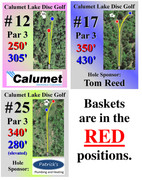Like many things, bi-directional tees could work in some places. Probably not on many wooded courses, where the transition path from a basket to the next tee is often a narrow trail. But I've used a few on "safari" type layouts.
Our private course has two overlapping layouts, with a few shared baskets or tees. It's low-traffic, so no problem; though at tournaments we only play one or the other at a time (and mark off the holes that don't apply). I suspect that some courses could do something like this, except open or close layouts every week or two. At the expense of extra baskets and teepads, but requiring no more land.
I once played a course with reversed fairways that played both ways, simultaneously. 9 holes out, then reverse and play 9 holes back, with tees and baskets at either end. It was a lousy course, but not because of that. It could work -- some places (and with low traffic).
*
I think the gold standard is dual tees (not just long/short), and multiple permanent targets, giving the players options instead of forcing them (as rotating baskets do). With the significant drawback of cost. And the limitation, like everything else, that not all land is suitable for this; some property features are best used for a single hole design.
Our private course has two overlapping layouts, with a few shared baskets or tees. It's low-traffic, so no problem; though at tournaments we only play one or the other at a time (and mark off the holes that don't apply). I suspect that some courses could do something like this, except open or close layouts every week or two. At the expense of extra baskets and teepads, but requiring no more land.
I once played a course with reversed fairways that played both ways, simultaneously. 9 holes out, then reverse and play 9 holes back, with tees and baskets at either end. It was a lousy course, but not because of that. It could work -- some places (and with low traffic).
*
I think the gold standard is dual tees (not just long/short), and multiple permanent targets, giving the players options instead of forcing them (as rotating baskets do). With the significant drawback of cost. And the limitation, like everything else, that not all land is suitable for this; some property features are best used for a single hole design.


